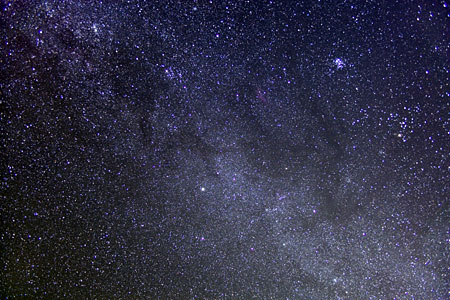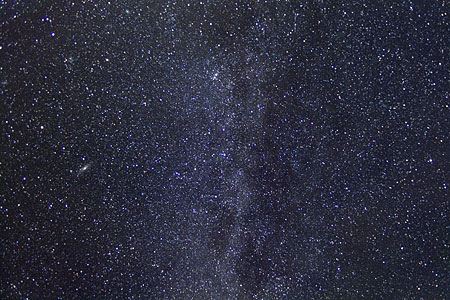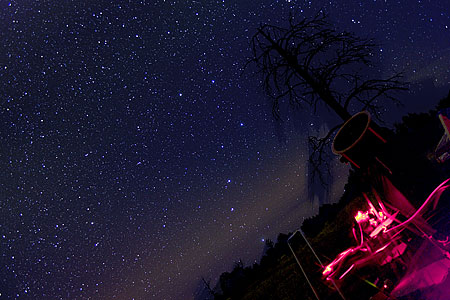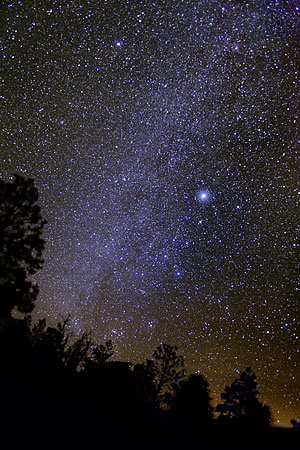On the evening of November 5th, I had an opportunity to observe at Anderson Mesa with Bill Ferris, Dave Saunders, and Marc Wiley. After a sketch of M45, and another try at G1/Mayall II, I moved on to some piggyback, wide-field photography. For all shots, I used my Canon Digital Rebel (300D) with the kit lens widened completely to 18 mm. I had the aperture as wide as it would go at f/3.5, the ISO set to 800, and was taking 10 minute exposures. For most of the images, I stacked 3 images on top of each other after subtracting dark frames and averaging in flat fields to remove noise and amp glow, and get rid of uneven illumination. The Skyview Pro mount was tracking great after some care with polar alignment, but then again, wide field photography is pretty forgiving of this. I spent about 30 minutes on focus, but once that was done, I was able to groove along with the exposures.
I was really happy to see a lot of DSOs showing up in the images...especially open clusters, and a variety of emission nebulae. After playing with the images some, I think that 5 minute exposures might work nicely as well. The 10 minute shots really pulled out the Milky Way and dark nebulae. It also helped with some of the fainter emission nebulae. But it also overexposed the brighter stars. That left me with less options to expose the images in Photoshop the way I want them. It's a trade-off. To get nicer range in faint areas, I sacrificed flexibility in the bright spots. I'm wondering if 5 minute shots will give me better play at both sides of the luminosity scale. I'm also dealing with purplish/magenta blooming around the brighter stars. I'm not sure how to get rid of that, short of painting it out...so I've just left it in.
This post shows the low resolution versions of the photos. I'm working on them one by one to map out the various details visible in each shot. I'll post larger, labeled versions of those as I finish them.

This image is centered around the constellation Auriga with major portions of Perseus showing in the upper left, and Taurus in the upper right. The Pleiades and Hyades are prominent, as are a number of dark dust clouds shaping the Milky Way in the area.

This image is centered around the constellation Cassiopeia with the Andromeda Galaxy, M31, prominent at left.

This image is centered around the constellation Orion, with Canis Major and Lepus below.

This image centers on the constellation Ursa Major. Bill Ferris' 18" 'Obsession' telescope is visible in the foreground along with red light trails from his sketching light.

This last image is centered on the constellation Canis Major. Sirius is the brightest star visible.





Hey Jeremy,
Your site is awesome, and your photos are really spectacular. I am working on a documentary where we mention the Dog Star, Sirius. I was wondering if you would allow me to make use of your image of Sirius? Can I pay you a licensing fee? The image would appear on screen for only about 5 seconds, and would not be used for marketing purposes. Again, your work is remarkable.
Thanks,
Chris
Hi Chris, thanks for your thoughts on the site. I've sent an email your way.
Jeremy